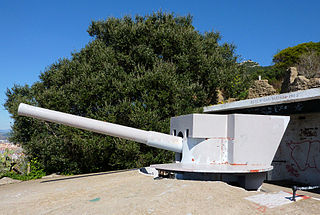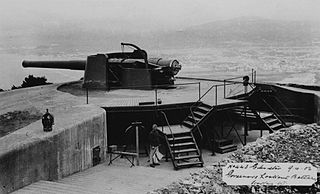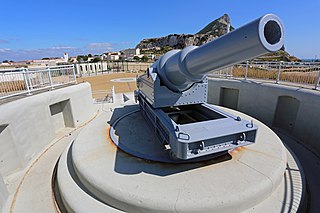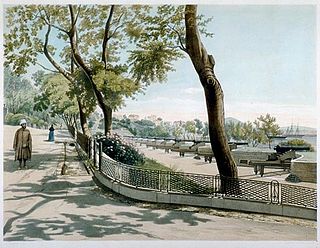
Devil's Gap Battery is a coastal battery in the British Overseas Territory of Gibraltar, overlooking the Bay of Gibraltar near the westernmost limits of the Upper Rock Nature Reserve.

Wellington Front is a fortification in the British Overseas Territory of Gibraltar. It was built in 1840 on a site established by the Spanish in 1618.

Buena Vista Battery was an artillery battery near the Buena Vista Barracks at the southern end of the British Overseas Territory of Gibraltar. It is located on a slight ridge in front of the nearby Buena Vista Barracks, which was once the base of the Royal Gibraltar Regiment.
West Battery is an artillery battery in the British Overseas Territory of Gibraltar. It is situated on the escarpment of Windmill Hill in the south of the territory.

Zoca Flank Battery is an artillery battery on the west side of the British Overseas Territory of Gibraltar.

Governor's Lookout Battery is one of the many artillery batteries in the British Overseas Territory of Gibraltar, which served to protect it against its many sieges. It is located off Signal Station Road within the Upper Rock Nature Reserve.

Harding's Battery is a restored artillery battery in the British Overseas Territory of Gibraltar. It is located at Europa Point and includes the Europa Sunken Magazine that is now used as a visitor centre.

White Rock Battery was an artillery battery in the British Overseas Territory of Gibraltar. It was located at the northern end of Catalan Bay at the point where the road down to the village meets the main road.

Alexandra Battery is a coastal artillery battery in the British Overseas Territory of Gibraltar. It was constructed at the neck of the South Mole to enfilade the coastal fortifications of Gibraltar. The battery stood on the site of several previous fortifications; it was built over the New Mole Battery, which was itself constructed on the site of an old Spanish fort in front of the Tuerto Tower.
Upper Battery is a former artillery battery in the British Overseas Territory of Gibraltar. It was located on the Upper Ridge of the Rock of Gibraltar at a site south of Signal Hill Battery and faced east over the Mediterranean. It mounted two 32-pdrs. in 1861. On the other side of the hill, three 24-pdrs. were mounted at Lower Battery. The two batteries were used for signalling and drill purposes.

The Prince of Wales Lines were a set of earthworks constructed in Gibraltar in 1756 on the orders of Lord Tyrawley, during his term as Governor of Gibraltar. They consisted of a series of retrenchments for guns and muskets constructed between the glacis of the South Front to the New Mole, south of Gibraltar's urban area.
The Prince of Wales Batteries were a group of artillery batteries built in Gibraltar between 1859–60 and named after Albert Edward, Prince of Wales, who laid the batteries' foundation stone on 13 May 1859. They stood on the West Side of Gibraltar, facing the sea, and were constructed on top of the former Prince Henry's Battery, built during the Anglo-Spanish War of 1762–3. The batteries were originally intended to mount four 32-pdr guns but they were extended to mount eleven guns in four groups. They were rebuilt again around 1872 when two new gun emplacements were built on top of Nos. 2 and 3 batteries to accommodate two 9-inch rifled muzzle loader guns.
Prince Henry's Battery was an artillery battery built in Gibraltar during the Anglo-Spanish War of 1762–63, adjoining the Prince of Wales Lines. They mounted three 32-pdr guns with two more 18-pdrs, six 12-pdrs and three 4-pdrs on the Lines. After 1841, the battery was rebuilt as a retired battery as part of a mid-19th century remodelling of Gibraltar's southern defences. They were eventually built over in 1859–60 when the Prince of Wales Batteries were constructed on the same site.
Princess Charlotte's Battery was an artillery battery built in Gibraltar during the 18th century. It was constructed in the Willis's Plateau area on the upper northern slopes of the Rock of Gibraltar. Formerly called Catalan Battery, it was renamed after Sophia Charlotte of Hanover, the wife of King Frederick I of Prussia, who was the brother of King George I of Great Britain. The battery saw service in the Thirteenth Siege of Gibraltar in 1727 and inflicted substantial damage on the attacking Spanish forces. By 1773 it had two 12-pdr guns. Its armament was upgraded to four 24-pdrs in 1834, and from 1885 to 1889 it mounted two 64-pdr rifled muzzle loaders.
The North Mole Elbow Battery was an artillery battery situated on Gibraltar's Old Mole, at the point where the mole turns north. It is recorded as mounting three 12-pdr guns in 1903. It mounted a Bofors 40 mm anti-aircraft gun during the Second World War along with a 6-pdr gun on a twin mounting for coastal defence purposes. At the end of the mole, another 6-pdr gun was installed on a twin mounting.
Mount Misery Battery was an artillery battery situated on the Upper Ridge of the Rock of Gibraltar. It was situated at Mount Misery, one of the peaks of the Rock. In 1901 its name was changed to Breakneck Battery at the suggestion of Major-General Sir John Slade of the Royal Artillery. Slade was to go on command British troops in Egypt from 1903 to 1905. Following his suggestion in 1899 that it would be a suitable position to accommodate a long-range coastal defence gun, a 9.2-inch breech-loading Mark X gun on a Mark V mounting was installed in 1906.

Prince Albert's Front is a curtain wall that formerly comprised part of the seafront fortifications of Gibraltar. It runs between the King's Bastion and Orange Bastion. The Front was constructed in 1842 after a report by Major General Sir John Thomas Jones recommended improving Gibraltar's seafront defences to guard against the threat of an amphibious assault. It was named after Prince Albert, Queen Victoria's prince consort. The Front straightened out the line of Gibraltar's coastal curtain wall; parts of the original curtain wall, some of which dates from the Moorish period over 500 years ago, can still be seen.

The Prince's Lines are part of the fortifications of Gibraltar, situated on the lower slopes of the north-west face of the Rock of Gibraltar. They are located at a height of about 70 feet (21 m) on a natural ledge above the Queen's Lines, overlooking the landward entrance to Gibraltar, and run from a natural fault called the Orillon to a cliff at the southern end of the isthmus linking Gibraltar with Spain. The lines face out across the modern Laguna Estate, which stands on the site of the Inundation, an artificial lake created to obstruct landward access to Gibraltar. They were constructed to enfilade attackers approaching Gibraltar's Landport Front from the landward direction.

The West Place of Arms is a place-of-arms in the British Overseas Territory of Gibraltar that was originally used as a troop assembly point. It is located in the gap between the North Bastion and its Counterguard, a structure built in 1804.

Victoria Battery was an artillery battery in the British Overseas Territory of Gibraltar. It was built in the 1840s on top of the earlier Princess of Wales Batteries following a report by Major-General Sir John Thomas Jones on Gibraltar's defences. The battery was located on the west side of Gibraltar and was one of a number of "retired" batteries in the territory, constructed to improve the coastal defences between Europa Point and the town.













